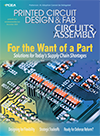Uncategorised
MTS500 Condor flying probe tester features rapid program development,
high throughput and handles large PCBs. Has four identical probes and
over 1000 fixed pins. Has a SMEMA-compatible conveyor; tests boards up
to 24 x 28". Test heads feature virtually maintenance-free x-y
positioning on a frictionless air cushion system.
DigitalTest, digitaltest.net Booth 5220
DigitalTest, digitaltest.net Booth 5220
AIM will highlight its lead-free soldering materials, including the
SN100C lead-free alloy. A live lead-free selective soldering
demonstration with the alloy is in booth 5437. SN100C, created by Nihon
Superior in Japan, is comprised of tin, copper and a small amount of
nickel. The nickel modifies its behavior so that in wave soldering it
exhibits fluidity comparable with tin-lead solder. Excess solder drains
easily off the joint, so bridges and icicles are avoided. Provides
smooth, bright, well-formed fillets which make inspection easy. Does
not contain silver or phosphorus, is less aggressive toward the copper
of traces and pads or the stainless steel components of soldering
equipment. Has a low dross rate.
AIM, aimsolder.com, Booth 5434
AIM, aimsolder.com, Booth 5434
Siemens Logistics & Assembly Systems Inc. this month unveiled its first machine manufactured in Singapore, the SIPLACE HS-60 high-speed pick and placer. It’s the result of 14 months of development and technology sharing with the company’s Munich headquarters, and symbolizes a new path for the Germany-based equipment giant. Siemens L&A Americas product manager Tom Foley spoke with Circuits Assembly.
After being given up by many for dead, business is heating up at BTU
International. In one of the industry’s top feel-good stories, the
maker of soldering equipment has posted three straight profitable
quarters, with net sales for the first half of 2005 up 12% to $28.6
million.
The stunning turnaround comes on the heels of 14 straight money-losing quarters, dating to March 2001. And it comes with several familiar faces back where they were before the company’s troubles began. In an exclusive interview with Circuits Assembly, company officials laid out the simple yet effective steps behind the resurgence, and pointed to several promising signs for continued success. (The company is exhibiting this week at AT Expo, booth 5139.)
The stunning turnaround comes on the heels of 14 straight money-losing quarters, dating to March 2001. And it comes with several familiar faces back where they were before the company’s troubles began. In an exclusive interview with Circuits Assembly, company officials laid out the simple yet effective steps behind the resurgence, and pointed to several promising signs for continued success. (The company is exhibiting this week at AT Expo, booth 5139.)
Thank you for your interest in Circuits Assembly magazine.
We will process your request in a timely manner.
Press Releases
{modulebot module=ApexNews1}
Corporate News
{modulebot module=ApexNews2}
Overheard
{modulebot module=ApexNews3}
Press Releases
- Industry Leaders Koh Young, Fuji America, and Creative Electron Unite to Launch The SMT Future Experience
- NanoFlowX Announces Strategic Partnership with Bentec Ltd to Accelerate PCB Protection Innovation Across Europe and India
- Strong signal for the industry: productronica 2025 drives positive industry trend
- Sharpen Your ESD Skills: CE3S Announces Desco’s First ANSI/ESD S20.20 Training Series for 2026


